At Giridhar Pai Associates LLP (GPA), we are at the forefront of understanding and addressing India’s housefly management challenges.
Each Indian summer and monsoon, as temperatures rise and humidity sets in, we witness a disheartening reality: an explosion in housefly populations and a persistent struggle to control them effectively.
From April to June, it’s common to see flies in fruit and vegetable shops, restaurants, hotels, and other Indian public spaces.
Effective housefly management is challenging but achievable through a multi-faceted approach.
India has access to excellent modern pesticides and various prevention tools like physical barriers (screens, double doors, door closers, auto door systems) and glue traps.
Yet, a critical gap persists in current Indian practices.
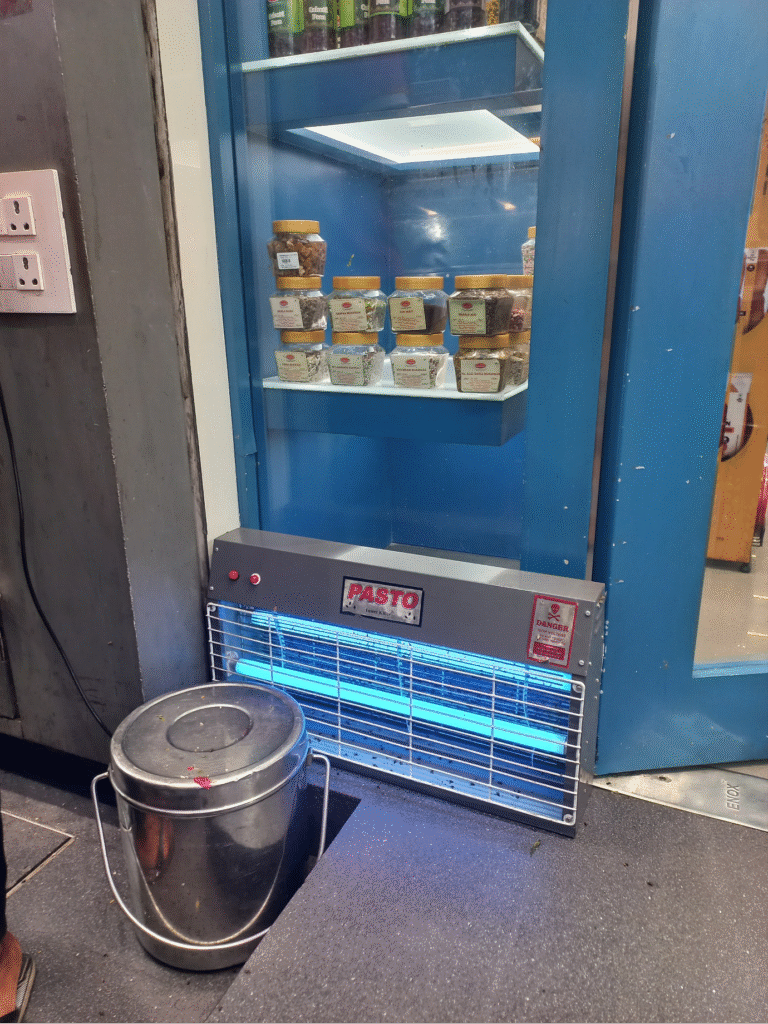
Fly killer outside a leading sweetshop – unwittingly attracting flies to the place
The Misconception: ILTs as a Standalone Solution
A widespread misconception is the over-reliance on insect light traps (ILTs) as the sole solution, mistakenly treating them as a control tool rather than a vital monitoring component.
Even highly effective products, such as Envu’s QuickBayt, struggle for widespread adoption, with many Pest Management Professionals (PMPs) still opting for older, less effective baits. When QuickBayt is painted in strips on walls and wetted periodically, it effectively controls outdoor housefly populations. But neither Indian PCOs nor Indian food businesses rely on QuickBayt, which is highly efficient in controlling houseflies and popular worldwide.
This prevailing focus on the lowest price often leads to the perpetuation of outdated “fly killers.” These first-generation devices fall far short of modern standards, especially compared to the superior performance of second-generation UV fluorescent tube catchers and our third-generation FLYght UV LED Insect Light Traps.
These wrongly chosen, improperly placed, and often aesthetically unpleasing fly killer devices are ubiquitous across India, particularly during peak fly season.
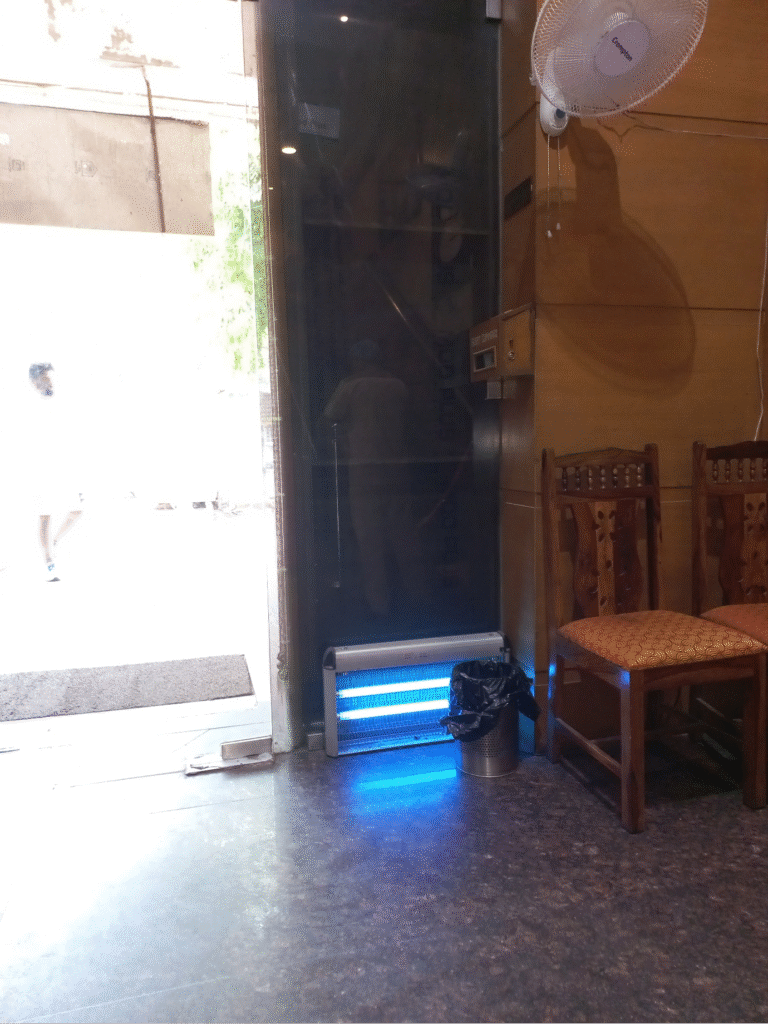
Fly killer on floor at a restaurant entrance
The Two Pillars of Effective Indoor Fly Management
True, effective indoor fly management hinges on two key strategies:
- Prevention: Rigorously restricting housefly entry through robust physical barriers.
- Monitoring: Diligently tracking flies that enter using strategically positioned and effective monitoring tools like FLYght Insect Light Traps.
Sadly, we frequently observe the cheapest “fly killers” placed incorrectly on floors, presenting an unsightly view with their catch trays full of dead flies and insect parts.
Even more concerning, these devices are often mistakenly used outdoors by businesses like sweet shops, restaurants, and hotels, inadvertently attracting more houseflies to the premises – a counterproductive and unhygienic practice that compounds the problem.
Houseflies pose a significant public health risk and have no place in food establishments.
Consumers and food safety authorities must demand higher standards from Indian food businesses, ensuring zero flies indoors where food is exposed.
Every food business in India is responsible for proactively preventing fly entry and utilising appropriate fly traps, including ILTs and glue traps, as part of a comprehensive fly management program.
Despite the availability of cutting-edge chemical pesticides and advanced third-generation UV LED ILTs like our FLYght One, FLYght Duo, and FLYght Deco, on-ground fly management in India often remains crude, ineffective, and continues to perpetuate fly-borne illness risks.
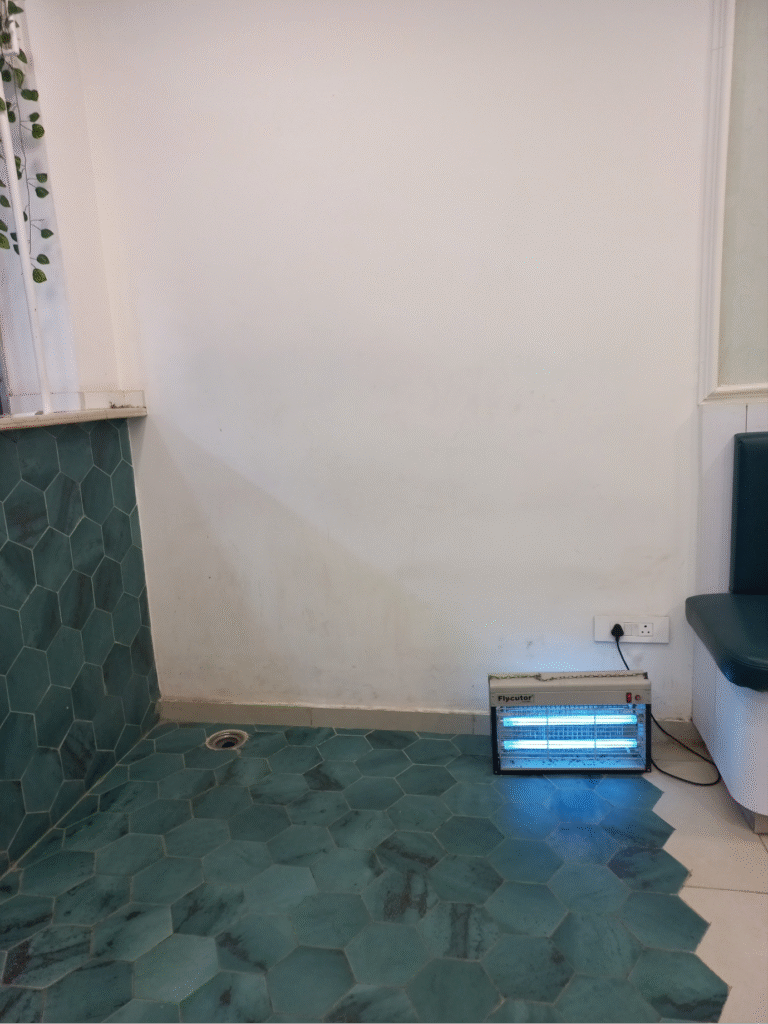
Fly killer on the floor inside a restaurant
Real-World Examples: Highlighting the Paradox
Our critical view isn’t just an observation; it’s a concern that drives our mission to elevate Indian fly management practices. Let me share two recent experiences that vividly highlight this “Indian fly control paradox”:
The Co-Working Space: A Case of Missed Opportunities
I recently observed a “fly killer” haphazardly placed on the floor between two doors while visiting a prominent co-working space in an upscale Mumbai business district. Several ceiling-mounted units dotted the ground floor, looking unsightly and out of place in the modern ambience.
I volunteered guidance, explaining that despite air curtains and double doors, flies were entering because occupants often lingered at the entrance, triggering automatic door sensors and inviting them in. I also suggested repositioning the ILTs to eye level for optimal performance.
Sadly, my insights went unacknowledged.
This co-working space relies on ineffective “fly killers” to address a seasonal fly problem largely due to their automatic doors opening unnecessarily.
My above experience at the co-working space illustrates a common problem: an investment in equipment without understanding its proper application or addressing the root cause of the fly infestation.
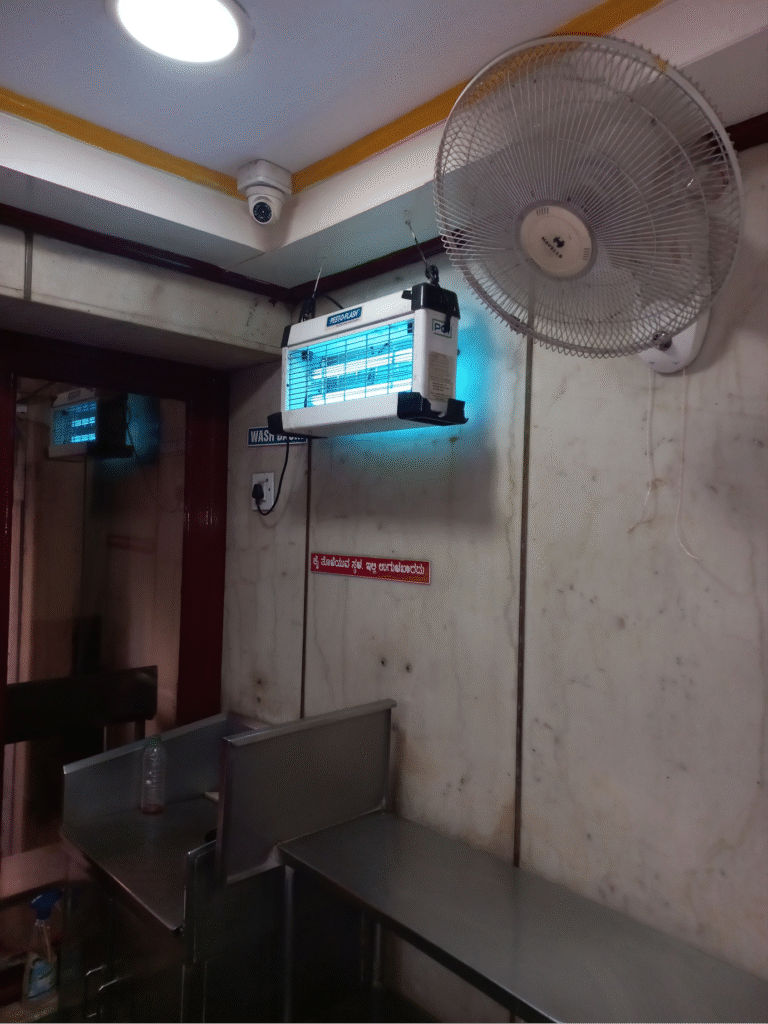
Fly killer above a restaurant handwash
The Sweet Shop: Battling Flies with Outdated Methods
More recently, I met with the purchase team of our city’s leading sweet shop chain. Their “solution” for monsoon fly control? Placing “fly killers” on the ground outside and inside their multiple outlets. Despite their best intentions, outdoor cooking and serving areas meant hordes of houseflies continued to buzz over food contact surfaces and products.
While they found our FLYght Deco trap effective, they deemed it “too small” for their severe monsoon fly problem across their numerous outlets.
I emphasised the need for modern fly baits, glue ribbons, and air curtains alongside door closers but couldn’t sway them.
Their reliance on rudimentary fly bait spraying, without professional pest control advice, further underscores the urgent need for education and adopting integrated fly management principles.
The Road Ahead: Embracing Modern Fly Management
India remains a unique market where reliance on outdated first and second-generation ILT technology still outsells advanced third-generation FLYght UV LED Insect Light Traps.
Combined with other crude fly control practices, using “fly killers” in food outlets with open food presents significant food safety risks to businesses and consumers alike.
Disturbingly, food businesses and their patrons often appear blasé about insect fragments from fly killers in the air, which can settle on food and be consumed unknowingly. Food safety auditors must actively disallow “fly killers” use in food preparation and serving areas.
It’s clear that true fly management goes beyond simply buying “fly killers.” It requires a comprehensive understanding of fly behaviour, proper equipment placement, and, most importantly, a proactive approach to prevention and continuous monitoring.
We are dedicated to changing this narrative by advocating a shift towards modern, effective, and hygiene-focused fly management. It’s time to stop “reliving the trauma” of outdated practices each year and embrace smarter solutions for a fly-free India.
At Giridhar Pai Associates, we empower the Indian pest control industry with the right knowledge and tools.
Our partners, Pestroniks Innovations Pte. Ltd., designed FLYght UV LED Insect Light Traps not as a standalone solution but as a crucial element in a modern, effective, and hygiene-focused fly management strategy.
Pre-launch studies and regular fly catch tests of the FLYght One, FLYght Duo, and FLYght Deco have consistently demonstrated excellent fly-monitoring capabilities.
In March 2025, GPA successfully launched the FLYght Deco for smaller spaces like bakeries, cafes, and restaurants, and numerous businesses have already chosen it for their fly monitoring requirements.
`
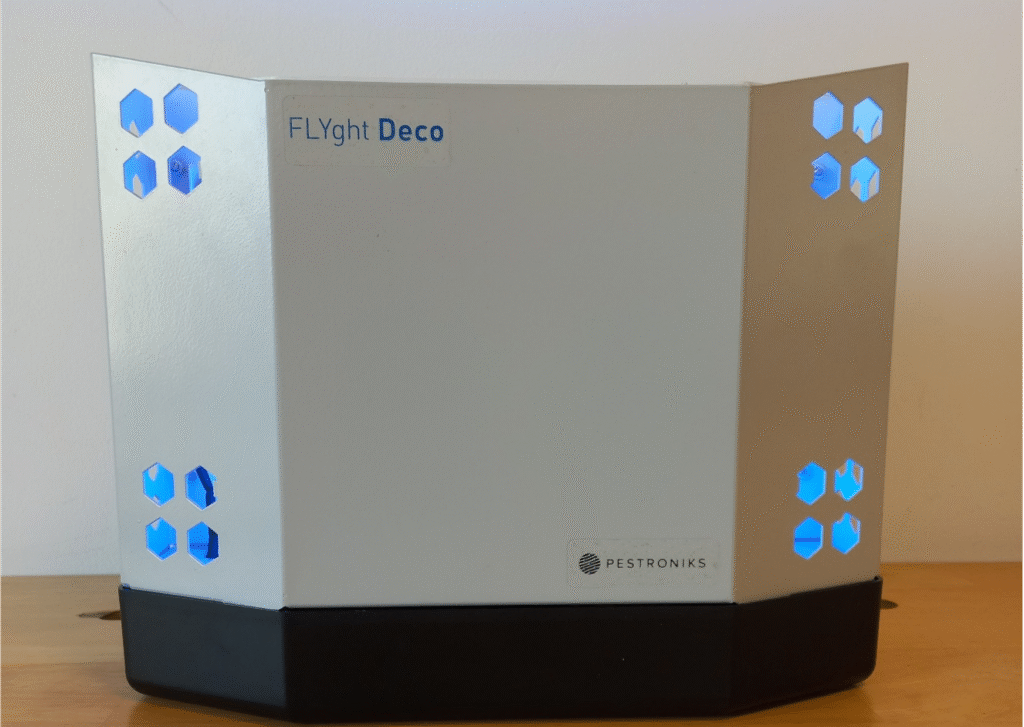
The FLYght Deco
Let’s move beyond ineffective practices and embrace a smarter approach to fly control by adopting the latest tools like FLYght Traps.
Contact us today to purchase a third-generation UV LED flycatcher that makes a difference. We would happily supply you with the right solution for your needs.
